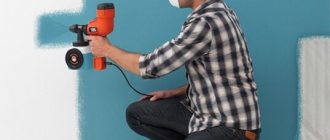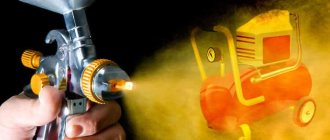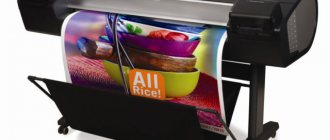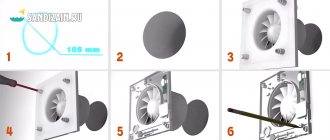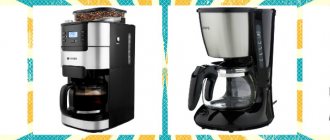The list of equipment necessary for minor repairs includes a spray gun for painting a car. The equipment is used for spraying paints and primers (air-drop method) on certain surfaces. The trade offers a wide range of tools that can be used not only for painting cars, but also for repair work.
Equipment in use
What is a spray gun
A special device with which enamel, varnish or any other liquid solution is applied is called a spray gun. Fine spraying allows you to obtain a thin and uniform layer, practically without smudges, on the surface being treated.
Important! The device helps to work on hard-to-reach areas, corners and relief surfaces not only on the car. It can even be used to paint the inside of central heating radiators and other areas with difficult access.
Why do you need a spray gun?
In addition to painting work, the car sprayer can be used:
- for whitewashing and priming walls and ceilings;
- varnishing wooden surfaces;
- applying anti-corrosion materials to metal in the garage;
- cleaning old wallpaper from walls - uniform moistening or applying a special composition to facilitate their removal;
- spraying plants in the garden with pest control compounds.
Some pastry chefs have managed to adapt equipment for velor cakes.
Important! The equipment is used for repairing premises at all stages of work, when painting vehicles or implementing creative ideas.
Spray marking
Device structure
The following components are included in car painting spray guns:
- handle - necessary for directing the sprayed composition and holding the device;
- tank - it contains the liquid composition used for spraying;
- trigger - sets the locking needle in motion, when pressed, paint begins to spray;
- nozzle - located at the front of the gun, the nozzle fits into part of the spray base.
For pneumatic models, the pressure regulator (p) is located in the rear area of the gun; it is necessary to adjust the level at which air is supplied. The second similar mechanism is a shut-off screw that regulates the intensity of supply of liquid material.
Device structure
Design of the spray gun
Sprayer device for car painting
For ease of work, the spray gun is made in the form of a pistol, which is why it is often called a paint gun. It consists of a body with a handle. At the bottom of the handle there is a fitting for connecting the pipeline from the compressor. Inside the body of the paint gun there are channels for supplying air and paint. All of them are connected to the sprayer head, with a nozzle installed in it, through which a stream of air with paint is sprayed.
The paint is supplied from the tank. The tank itself can have an upper, lower or upper side location.
The air and paint supply is controlled by a trigger. When the trigger is released, it blocks the paint supply channels; in order to open these channels, you need to squeeze the trigger. This makes it possible to interrupt work to move to another surface, for example, when painting only individual elements of the car body.
Spray gun spray systems
Pneumatic equipment is divided according to the technological features of spraying:
- with high p - HP system;
- small p with small volume - HVLP;
- small volume and p - LVLP.
Important! When purchasing equipment, you need to pay attention to the abbreviation present in the model names.
HP system
The devices are characterized by high output p values, reaching up to 1.5 atmospheres. Fast and uniform application of the solution is ensured by a wide forming torch and high air flow.
The advantages of the system include:
- short turnaround time;
- high-quality spray;
- homogeneity of the colorful torch.
The disadvantages are presented:
- high air consumption, requiring a powerful compressor;
- high p values, which require certain skills in handling the tool;
- consumption - about 60% of materials go into the “fog”.
Important! Due to severe air pollution, personal protective equipment must be used when working with garage equipment.
HP system
HVLP system
It is characterized by a lower output p, which helps to obtain a more dense application. Low rates allow you to keep the device close to the surface, reducing paint consumption and air pollution.
The advantages of the system include good coating quality and a small loss of solution of 30%. The disadvantages are high cost, the need to use a powerful compressor due to air consumption.
Important! Saving almost 20% of paint and varnish materials allows you to quickly recoup the cost of purchasing equipment.
HVLP system
LVLP system
During operation, the equipment requires minimal volumes of air at the input; it is resistant to changes in p in the compressor. The list of advantages of the system includes:
- minimal loss of solution - no more than 20%;
- resistance to unstable p;
- low air consumption.
The disadvantages of the system include its high cost and the need for skills to operate the device.
LVLP system
Let's sum it up
You can do a lot of car coating work yourself. If you really want, you can purchase and use painting equipment in your own garage. You can only finish a car well if you have everything you need for this process. Often, the first time it is not possible to create a really high-quality layer of paintwork, and this depends not on the quality of the devices, but on the experience of the master.
There is an opinion that a good specialist with significant experience can paint a car even with the cheapest spray gun. This is impossible, since the quality of the paint spray determines the actual characteristics of the finishing layer. If you pay attention to the work of expensive craftsmen, for them the ability to choose professional devices is one of the most important parameters for achieving a good result. So pay special attention to this condition of the spray booth.
How to choose a spray gun for painting a car
Before purchasing a device, you need to familiarize yourself with the basic quality characteristics. The paint consumption and the quality of the work performed depend on the indicators.
Receiver material
The choice depends on the class of equipment:
- for HP - receiver at 4-6 atm;
- HVLP - 1.5-4 atm.;
- LVLP - 0.7-2 atm.
Important! The receiver is selected individually for each brand of spray gun.
Location and volume of the tank
The location of the tank does not affect the operation of the air gun:
- installed below - selected by craftsmen who are comfortable working with it;
- top - uses all the paint material to the last drop.
Plastic tanks are used for acrylic and water-based paints; metal tanks are used for solvent-based materials. The volume is selected at the discretion of the user - excessive weight can interfere with work.
Bottom position of the tank
Performance and Power
For domestic purposes, equipment with a power of up to 500 W is used; professional models require higher performance. The latter are capable of working with materials of any viscosity; they are always distributed evenly.
The performance of guns is the volume of air entering and exiting. Stable spraying is ensured by the high level of efficiency of the spray gun.
Nozzle diameter
The parameters differ depending on the type of paint solution used:
- local application - 1.2 mm;
- varnishes, water-soluble composition, base - 1.3 mm;
- acrylic and varnish - from 1.4 to 1.7 mm;
- primer - from 1.6 to 2.2 mm;
- liquid putty - from 2.5 to 3 mm.
If the nozzle diameter is chosen incorrectly, it may become clogged with particles that are too large.
A tutorial for beginners: how to paint a car with your own hands
It is better to paint the car in a well-lit place, if this happens in the garage - dust, cobwebs, and dirt should not fall on the car. The stages of preparation for painting look like this.
- The body is thoroughly washed, all dust, traces of bitumen and grease are removed. Only special solvents or White Spirit should be used.
- Bumpers, lighting equipment, decorative elements, wheel protection in arches and other parts that cannot be painted are dismantled.
- The condition of the coating is being studied. All defects (chips, cracks) are marked with chalk or acrylic paint.
- In the marked areas, the paint is knocked down to the metal with a screwdriver, the areas are sanded with sandpaper with a grain size of 60-80, achieving a smooth transition into an intact paint surface.
- Defective areas are puttied. To do this, a finishing mixture is used; it must be smoothed, achieving a flat surface that protrudes as little as possible above the intact paint.
- After the putty has dried (according to the manufacturer's instructions), sanding is done with sandpaper from 120 to 600, ideally leveling the defect area with the surface of undamaged paint.
Important! At the final stage of grinding, if the performer is too eager, an additional layer of putty may be necessary to level the surface.
Before painting, you should protect any unnecessary areas with masking tape, newspaper or film. The entire surface of the body is evenly sanded with 1200 grain until matte. After this, dust is removed, wiped with White Spirit, followed by drying. The car is ready for painting.
- The enamel of the desired color should be diluted. The mixture is thoroughly mixed. By adding a solvent, the following result is achieved: after dipping the metal rod 1-2 mm and removing it, the paint should drain at a speed of 3-4 drops per second. After this, the paint is poured through a filter (for example, a piece of nylon stocking) into the spray gun container.
- In most cases, it is recommended to work with a 1.4 mm nozzle at a spray inlet pressure of up to 3 atm. Before applying paint to the car, you should make sure that the spray is even and adjust the spray pattern. Setting up the spray gun for painting a car is done on an unnecessary surface. After this, coloring is done.
- Paint your car correctly - starting from the roof. The gun should be held so that there is 120-250 mm from the nozzle to the surface of the body. You need to apply paint in motion, turning on the feed when the sprayer moves and stopping it before reaching the final point of the trajectory.
- The paint on the car must be applied in 2-3 layers, the pre-drying interval between them is from 15 to 20 minutes. This is the only way to achieve a uniform, rich and authentic color when working with your own hands. After painting is completed, the car is left in a warm, moderately ventilated room with a temperature of at least 20 degrees Celsius for 1-1.5 days.
Upon completion of the drying process, remove protective films, newspapers, and masking tape. The paint-filled points of the screw connections are carefully cut through with taps and dies. After this, they install all previously removed equipment in their original places and enjoy the updated look of the car.
Which compressor is suitable for a spray gun?
The device is selected in accordance with the characteristics of the pistol:
- supply of a certain volume at the required p - the compressor capacity in cm3 should be 1.5 times greater than what is needed for the spray gun;
- insufficient performance will not give good atomization;
- the air supply parameter must be clarified - some compressors only give good pressure indicators.
Hoses with fittings are of great importance. A quarter inch cord will interfere with the stable flow of air; for normal operation, a 3/8 inch cord with fittings that do not impede air flow is required.
Compressor for spray gun
Manufacturers of spray guns
The TOP popular equipment suppliers include:
- “GAV” is a budget line for beginners learning the nuances of painting; the devices are used for applying acrylic and basic base;
- “Walcom” - used for professional auto repair shops, the manufacturer produces a variety of models;
- "SATA" - equipment is characterized by resistance to wear and long service life.
Important! In order not to wonder which spray gun you can choose for painting a car, you need to familiarize yourself with the characteristics of the models.
Top spray guns for painting cars
The rating of popular devices for paint and varnish work includes:
- Devilbiss Flg 5 RP is a professional budget model that requires 270 liters of air every minute and produces a torch 280 mm wide. The device has an aluminum body, a needle and nozzle made of stainless steel. Works with all types of materials, with the exception of water-based solutions. The equipment is supplied without a case, in cardboard packaging.
- Walcom ASTUROMEC 9011 HVLP 210 is an inexpensive gun that allows you to paint surfaces with high quality. Requires 220 liters per minute of air, despite the built-in HVLP system. The package includes a gearbox, a convenient plastic case, spare parts: springs, retaining rings, gaskets, air valve rod. Additionally, oil for lubrication of contacting parts and a cleaning kit are supplied.
- Walcom SLIM S HVLP - has a high coefficient of solution transfer to the surface, within 85%. During operation, 200 liters of air per minute are used. The package includes a case, a regulator with a pressure gauge, oil, spare parts, a cleaning brush and a key.
- SATAjet 1000 B RP - the device is suitable for fine and large-scale processing. Requires a compressor with a capacity of 275 liters per minute, distributes about 60% of the solution. The package contains a cleaning brush and keys.
- Anest Iwata W-400 RP is a spray gun with standard pressure and high-quality assembly. It is characterized by a high speed of application of solutions, subject to high air consumption - up to 370 l/min, which requires choosing the right compressor (not all models can provide the required parameters). The torch width is 280 mm, the equipment is supplied in a cardboard package with a colorful filter and a cleaning brush.
It is necessary to select equipment based on build quality, tank capacity, its position and performance. The user must focus on popular models, in accordance with their purpose, and select devices that are suitable for hand.
Compressor requirements
Beginners often make one common mistake. Having a pneumatic compressor in the garage or workshop, they believe that its characteristics will be sufficient for any spray gun. In practice this is not the case. Each device of a certain class puts forward its own requirements for the supercharger.
- The HP system will require up to 5 atm of input pressure and a capacity of up to 300 liters of air per minute.
- For HVLP, the compressor must produce 3 atm at an air flow of 360 or more liters per minute. In this case, it is recommended to equip the devices with moisture and oil filters, since the supercharger has to work almost at the limit of its capabilities and continuously.
- The LVLP system will require up to 2 atm at the inlet and pumping at 150-350 liters per minute.
In order not to make a mistake in choosing and not to encounter troubles, it is recommended that before going to the store you find out the exact characteristics of the compressor you already have in stock. Or buy a complete set of equipment. There is another option: electric spray guns are quite popular among beginners.
